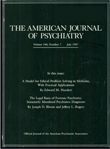Behavioral aspects of panic disorder
Abstract
The behavioral approach to panic disorder distinguishes between agoraphobia and nonsituational panic and emphasizes the handicap to the patient caused by avoidance of agoraphobic situations. Agoraphobia is a more viable label than panic disorder. Behavioral treatment consists of delineating the patient's agoraphobic avoidance and panic profile and developing a self-exposure program to produce habituation. Systematic exposure to agoraphobic situations is usually of durable efficacy, and the treatment requires little time from clinicians. Antidepressant drugs, which do not interfere with exposure, are a useful addition when dysphoria is present, but they can have troublesome side effects.
Access content
To read the fulltext, please use one of the options below to sign in or purchase access.- Personal login
- Institutional Login
- Sign in via OpenAthens
- Register for access
-
Please login/register if you wish to pair your device and check access availability.
Not a subscriber?
PsychiatryOnline subscription options offer access to the DSM-5 library, books, journals, CME, and patient resources. This all-in-one virtual library provides psychiatrists and mental health professionals with key resources for diagnosis, treatment, research, and professional development.
Need more help? PsychiatryOnline Customer Service may be reached by emailing [email protected] or by calling 800-368-5777 (in the U.S.) or 703-907-7322 (outside the U.S.).



